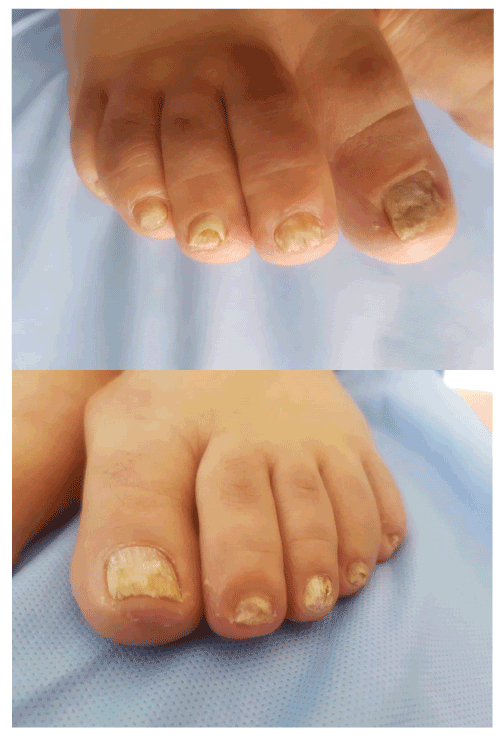42-year-old patient, with no particular medical historty, consulted for a change in the appearance of the toenails, the change began 2 years ago. It initially affected the nails of the 2 big toes and then, gradually, spread to all the toenails.
Clinical examination showed a yellowish appearance of the nail plate, diffuse thickening on all the toenails, subungual hyperkeratosis with onychodystrophy and a friable appearance of the nails of the big toes.
We did not objectify melanonychia, nor Periungual inflammation, And the nails of the 2 hands were healthy.
Nail sampling for mycological examinations with culture and microscopy was performed on suspicion of onychomycosis. And the results were in favor of Alternaria alternata onychomycosis, the diagnosis was confirmed on a second sample.
Non-dermatophytic mold onychomycosis (NDM) is rare, prevalence is 0.76% to 15% depending on the series; the most frequent species are Aspergillus, Neoscytalidium, Fusarium.
Alternaria is the rarest NDM, it represents 0.08% to 2.5% of all onychomycosis and 3 to 10% of NDM; These infections have no characteristic clinical signs, but they are known by their sensitivity to itraconazole, voriconazole and posaconazole, resistance to griseofulvin, 5-flucytosine and fluconazole, and discreet sensitivity to ketoconazole (Figure 1).

Figure 1. A rare case of onychomycosis induced by Alternaria alternata
Editorial Information
Editor-in-Chief
Dr. Dennis Mans
Article Type
Clinical Image
Publication history
Received date: February 07, 2020
Accepted date: February 25, 2020
Published date: March 03, 2020
Copyright
©2020 Issoual K. This is an open-access article distributed under the terms of the Creative Commons Attribution License, which permits unrestricted use, distribution, and reproduction in any medium, provided the original author and source are credited.
Citation
Issoual K, Louizi I, Dahhouki S, Gallouj S, Ellloudi S, et al. (2020) A rare case of onychomycosis induced by Alternaria alternata. Glob Dermatol 5: DOI: 10.15761/GOD.1000223
Corresponding author
Issoual K
Department of Dermatology, Hassan II Hospital University, Fez. Morocco
E-mail : bhuvaneswari.bibleraaj@uhsm.nhs.uk

